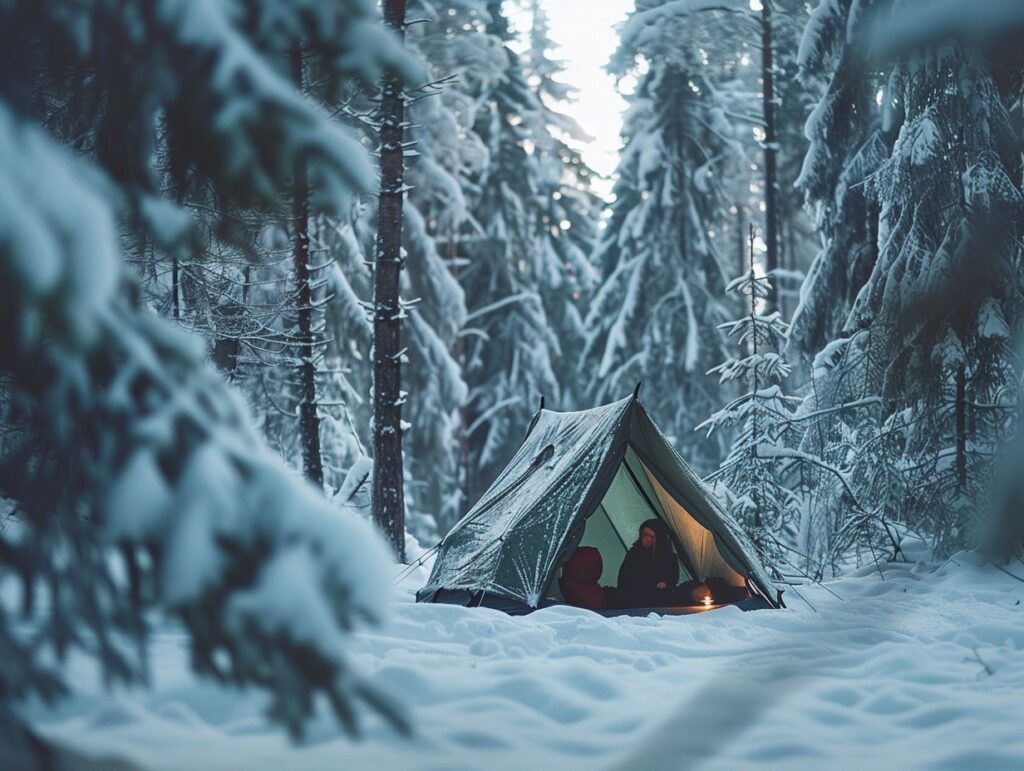Planning a snow camping adventure and unsure about essential items to pack? From must-have clothing items to necessary gear and equipment, this article has you covered.
Learn how to pack light for snow camping, important safety precautions for extreme weather conditions, choosing the right campsite, staying warm and comfortable in the snow, and having fun with winter sports activities.
Prepare to make the most of your snow camping experience with these helpful tips and tricks!
Key Takeaways:
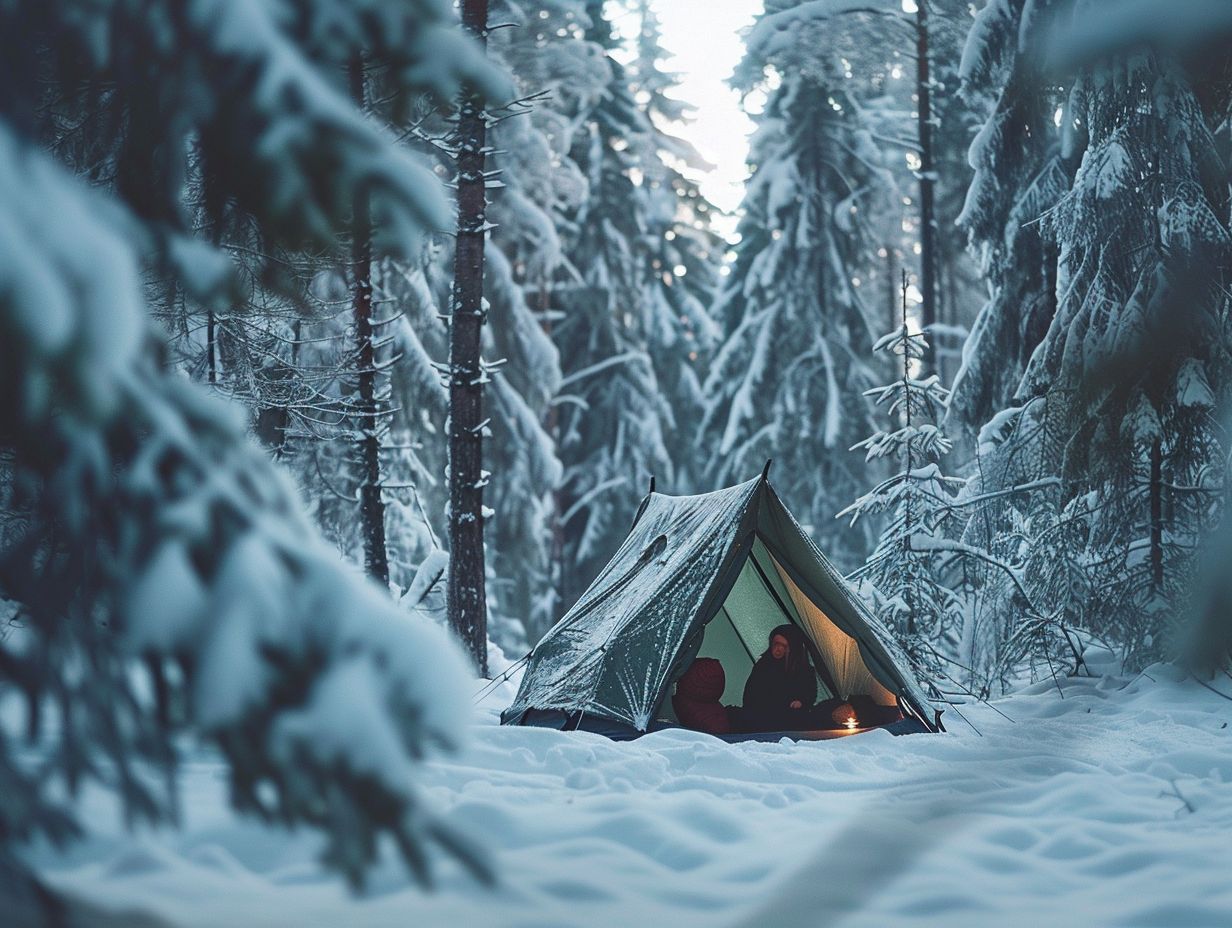
- Layer up with the necessary clothing items and pack light for snow camping.
- Be aware of potential dangers and prepare for extreme weather conditions and wildlife encounters.
- Choose a suitable campsite, properly set up your tent, and stay warm by insulating your tent, sleeping properly, and cooking efficiently.
What are the Essential Items for Snow Camping?
Snow camping is a rewarding outdoor venture that requires careful preparation. Ensuring that one has the necessary essential items can significantly affect the quality of the winter trip, differentiating between a comfortable experience and a cold, unpleasant ordeal.
What are the Must-Have Clothing Items?
Proper attire is essential for maintaining warmth and comfort during snow camping. It is recommended to wear layers, beginning with thermal base layers, followed by insulating layers such as a fleece jacket, and capped off with a hardshell jacket and a parka-grade puffy to provide protection against the elements.
Plus layering, it is important to wear moisture-wicking socks and sturdy, insulated snow boots to ensure dry and warm feet in snow conditions. Investing in high-quality waterproof trousers is advisable to shield the legs from snow and moisture.
Equally important are good-quality gloves or mittens and a thermal hat to protect the extremities from freezing temperatures. To prevent heat loss from the neck area, a neck gaiter or scarf is recommended to complement the winter camping attire.
What are the Necessary Gear and Equipment?
For a snow camping expedition, it is imperative to have the essential gear which comprises a winter-grade sleeping bag and sleeping mat for insulation, snow safety equipment, and practical camping gear like the MSR WhisperLite stove, Nalgene bottles, Sawyer Squeeze water filter, and Cleanwaste’s Go Anywhere Toilet Kit.
The winter-grade sleeping bag and sleeping mat play a vital role in providing insulation and warmth, particularly in cold and snowy conditions. In addition, snow safety gear such as avalanche beacons, shovels, and probes are critical tools that can potentially save lives during emergencies.
The MSR WhisperLite stove is relied upon for its dependable heating capabilities for meal preparation, while Nalgene bottles serve as durable receptacles for water storage. Moreover, the Sawyer Squeeze water filter guarantees the provision of safe drinking water.
When selecting equipment, it is crucial to prioritize quality, durability, and weight as pivotal factors to augment the overall snow camping experience.
How to Pack Light for Snow Camping?
When preparing for a snow camping expedition, it is advisable to pack efficiently by selecting lightweight gear and a well-organized snow camping system.
This may involve opting for a Featherweight duvet as opposed to a heavier sleeping bag and including a hot water bottle with a tightly fitting lid for additional warmth without increasing bulk.
Utilising multi-functional items, such as a lightweight cooker that can serve both as a heat source and cooking implement, can help minimise the weight of your rucksack while maximising utility. Choosing outer layers constructed from advanced materials like Gore-Tex or Pertex can offer insulation and weather protection without unnecessary added weight.
Focusing on essential items, such as a compact first aid kit, high-energy snacks, and a reliable navigation tool, ensures you are suitably equipped for a safe and enjoyable snow camping experience.
What are the Safety Precautions for Snow Camping?
Safety precautions are of utmost importance when engaging in snow camping, particularly in the face of severe weather conditions and potential dangers such as avalanche-prone areas and unpredictable snow conditions.
How to Prepare for Extreme Weather Conditions?
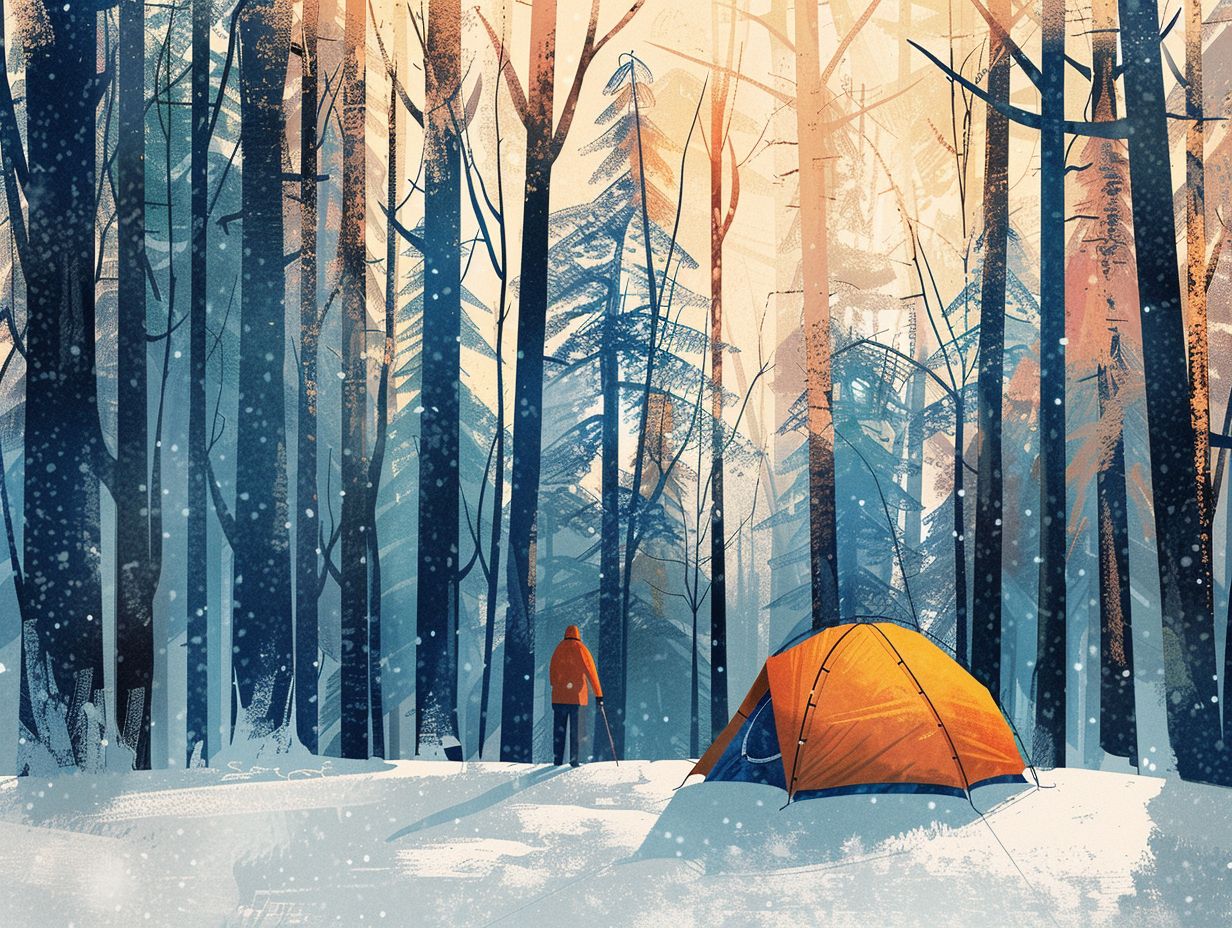
Preparation for severe winter conditions during backcountry trips involves the utilization of a hardshell jacket, a parka-grade puffy, and additional insulating layers to maintain body warmth and provide protection against the cold.
Furthermore, beyond appropriate attire, the presence of suitable gear and accessories is imperative to secure safety amidst harsh environments.
This includes insulated waterproof footwear, thermal gloves, head coverings like a beanie or balaclava, and high-quality woollen socks to ensure warmth and dryness in the feet.
Adequate preparation also incorporates the regular monitoring of weather forecasts and the subsequent adjustment of plans as necessary.
Additionally, access to a reliable communication device and the presence of emergency supplies such as a first aid kit, an emergency blanket, and high-energy snacks are essential for unforeseen circumstances.
What are the Dangers of Snow Camping?
Snow camping presents various hazards, such as the potential for avalanches in mountainous terrains, exposure to frigid temperatures, and the possibility of wildlife encounters.
Avalanches, often triggered by unstable snowpack, represent a significant danger to individuals engaging in snow camping. It is essential to evaluate the risk of avalanches in the vicinity and avoid establishing camp in areas susceptible to slides.
Remaining prepared for abrupt weather changes is imperative, as hypothermia and frostbite are genuine threats in cold climates. To mitigate these risks, it is advisable to always carry suitable clothing, insulation, and equipment.
In regions inhabited by bears, adhering to proper food storage practices and bear safety protocols is critical to prevent hazardous interactions with wildlife while engaged in snow camping.
How to Stay Safe from Wildlife?
Ensuring safety from wildlife during snow camping entails acquiring a campfire permit to dissuade animals, correctly storing food, and maintaining awareness of both surroundings and snow conditions.
While selecting a campsite for snow camping, it is advisable to opt for an area that is distant from animal trails and their natural habitats in order to diminish the likelihood of wildlife encounters. Additionally, situating the camp away from bodies of water can reduce the probability of attracting animals.
Adhering to proper food storage practices, such as utilising bear-proof containers or suspending food in a secure manner away from the campsite, is critical in deterring animals from being enticed to the tent.
Incorporating general wilderness safety protocols like generating noise while trekking and upholding a pristine campsite further contribute to deterring wildlife interactions.
How to Choose the Right Campsite for Snow Camping?
Selecting the appropriate campsite for a snow camping expedition requires evaluating snow conditions, considering the proximity to flowing water, and choosing a suitable location for setting up a snow kitchen and other necessary camp facilities.
What are the Factors to Consider?
When selecting a campsite for snow camping, it is important to take into account various factors such as snow conditions, proximity to avalanche terrain, availability of running water, and a suitable area for establishing a snow kitchen.
Snow conditions play a critical role in determining the safety and enjoyment of the camping experience. Optimal conditions include compacted snow which facilitates tent setup and provides good insulation.
It is imperative to choose a location that is a safe distance away from avalanche-prone areas to mitigate risks. Access to running water is essential for drinking, cooking, and maintaining cleanliness. Furthermore, identifying a proper location for setting up a snow kitchen that is flat and shielded from the wind can streamline cooking activities.
By carefully evaluating these considerations, individuals can identify an appropriate campsite that aligns with their needs and preferences for a successful snow camping expedition.
How to Set Up Camp in the Snow?
Establishing a base in a snowy environment entails the creation of a snow kitchen, ensuring the proper anchoring of the tent, and arranging the sleeping mat and sleeping bag to optimise both comfort and insulation.
Commencing the setup of a snow kitchen involves identifying a level snow-covered surface suitable for the safe placement of a stove or the construction of a rudimentary fire ring.
Before commencing any activities, it is imperative to clear the designated area of any loose snow to minimise the risk of accidents.
Subsequently, the collection of rocks or the assembly of snow blocks serves to construct a windbreak around the cooking location, thereby shielding the open flame from the effects of strong winds and aiding in the regulation of a consistent cooking temperature.
It is essential to maintain a safe distance between any flammable materials and the cooking area to mitigate the potential for fire hazards.
What are Some Tips for Staying Warm and Comfortable in the Snow?
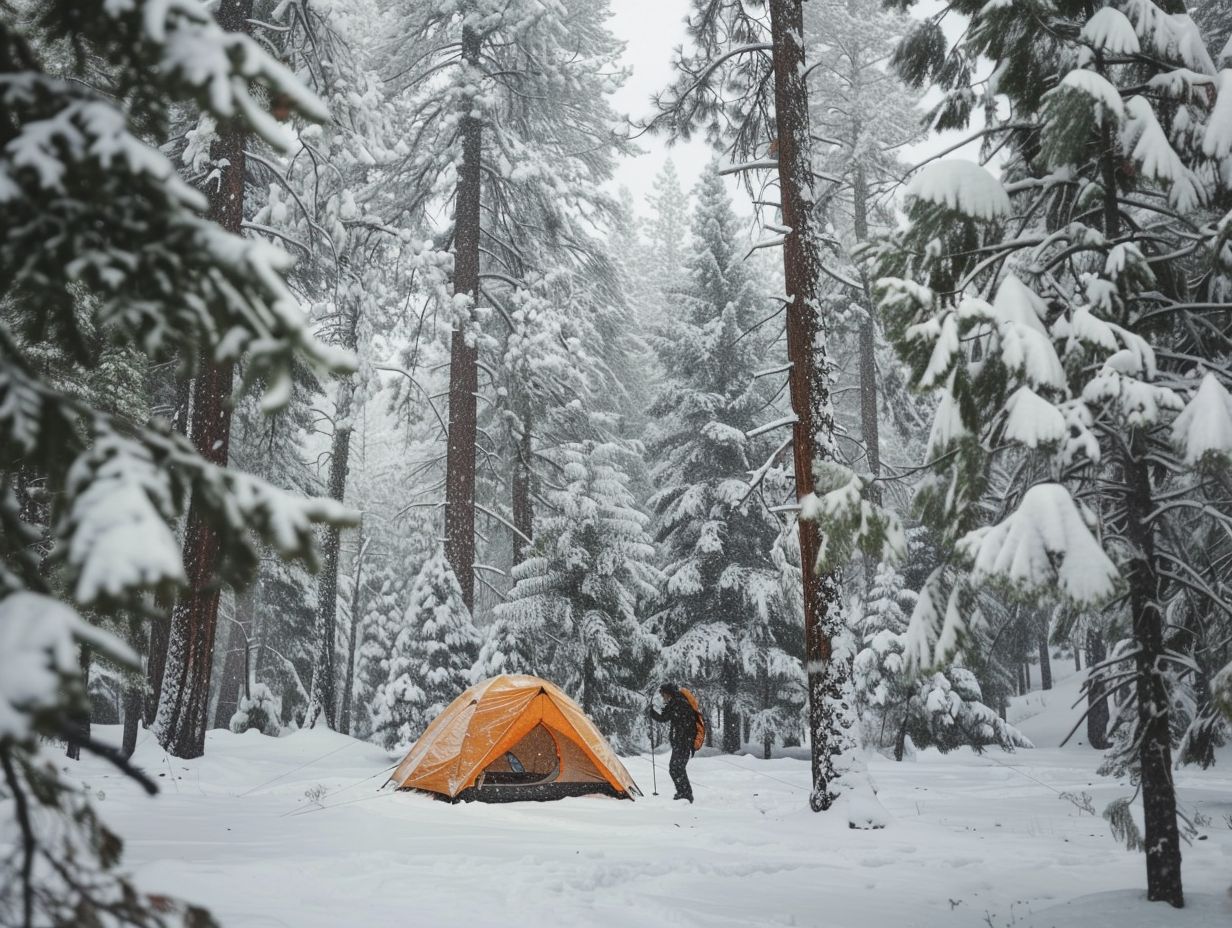
Ensuring warmth and comfort during a snow camping expedition necessitates the utilisation of specialised sleeping bags and sleeping pads to effectively retain body heat. Additionally, adherence to various practical strategies can be instrumental in combating the cold temperatures typically experienced in such environments.
How to Insulate Your Tent?
The process of insulating a tent for winter camping entails the strategic placement of additional layers both underneath and surrounding the sleeping area, as well as the implementation of a reliable snow camping system aimed at enhancing the retention of warmth.
To ensure effective insulation within the tent, the initial step involves the introduction of a thick groundsheet to serve as a protective barrier against the cold ground.
Supplementing this foundational layer, the positioning of insulating foam pads or air mattresses beneath the sleeping bag serves to further reduce heat loss.
In terms of wall insulation, the hanging of insulating blankets or tarps along the inner walls of the tent facilitates the retention of warm air within the sleeping quarters. Additionally, the use of a four-season tent equipped with a rainfly and vestibules offers additional insulation.
The maximisation of warmth within the tent during snow camping activities can be achieved through the use of a hot water bottle within the sleeping bag, wearing thermal layers, and avoiding excessive ventilation throughout the night.
What are the Best Ways to Stay Warm While Sleeping?
To maintain warmth while sleeping in cold weather conditions, it is recommended to use high-quality sleeping bags and sleeping mats to retain body heat. Additionally, the use of a hot water bottle can be considered to enhance warmth.
The positioning of the body during sleep plays a crucial role in determining the level of warmth experienced throughout the night. Optimal warmth retention can be achieved by adopting a foetal position or curling up, as this minimises the surface area exposed to the cold.
Furthermore, investing in insulated sleeping equipment such as a sleeping bag equipped with a hood and draft tubes can effectively trap heat.
In situations where temperatures significantly decrease, additional heat sources like hand warmers or portable camping heaters can be used to provide extra warmth, ensuring a restful night’s sleep in cold environments.
What are Some Tips for Cooking in the Snow?
Preparing meals in snowy conditions necessitates the establishment of a snow kitchen, utilization of cookware equipped with snug lids for heat preservation, and selection of high-calorie foods to sustain energy levels.
When establishing the snow kitchen, it is advisable to locate a sheltered area to mitigate wind exposure and lay a tarp to maintain a dry working environment. Opt for cookware that is both lightweight and robust, capable of withstanding the frigid temperatures.
Consider employing a portable or camping stove that can be easily ignited in the snow. Prioritize stocking up on energy-dense foods like nuts, granola bars, and dried fruits, which offer rapid energy boosts to keep you warm and energized during your outdoor winter pursuits.
What are Some Fun Activities for Snow Camping?
Snow camping provides a variety of enjoyable activities and winter sports that can enhance your outdoor experiences and create lasting memories during the winter season.
How to Stay Active and Safe in the Snow?
Ensuring safety and preparedness during snow-related activities requires a comprehensive understanding of snow conditions, appropriate selection of outdoor pursuits, and implementation of safety measures throughout winter excursions.
Vital to safety during engagements in snow-related activities is the consistent monitoring of weather forecasts and snow conditions within the vicinity.
Furthermore, it is advisable to communicate one’s itinerary to a trusted individual prior to embarking on snowy wilderness endeavors, ensuring that someone is informed of the intended route and estimated return time.
Equally essential is the carriage of critical safety equipment, such as a first aid kit, avalanche beacon, and a shovel, particularly when venturing into regions characterised by unstable snowpack.
By being adequately prepared and maintaining a vigilant approach, individuals can significantly enhance their chances of remaining safe and relishing their winter adventures.
What are Some Fun Winter Sports to Try?
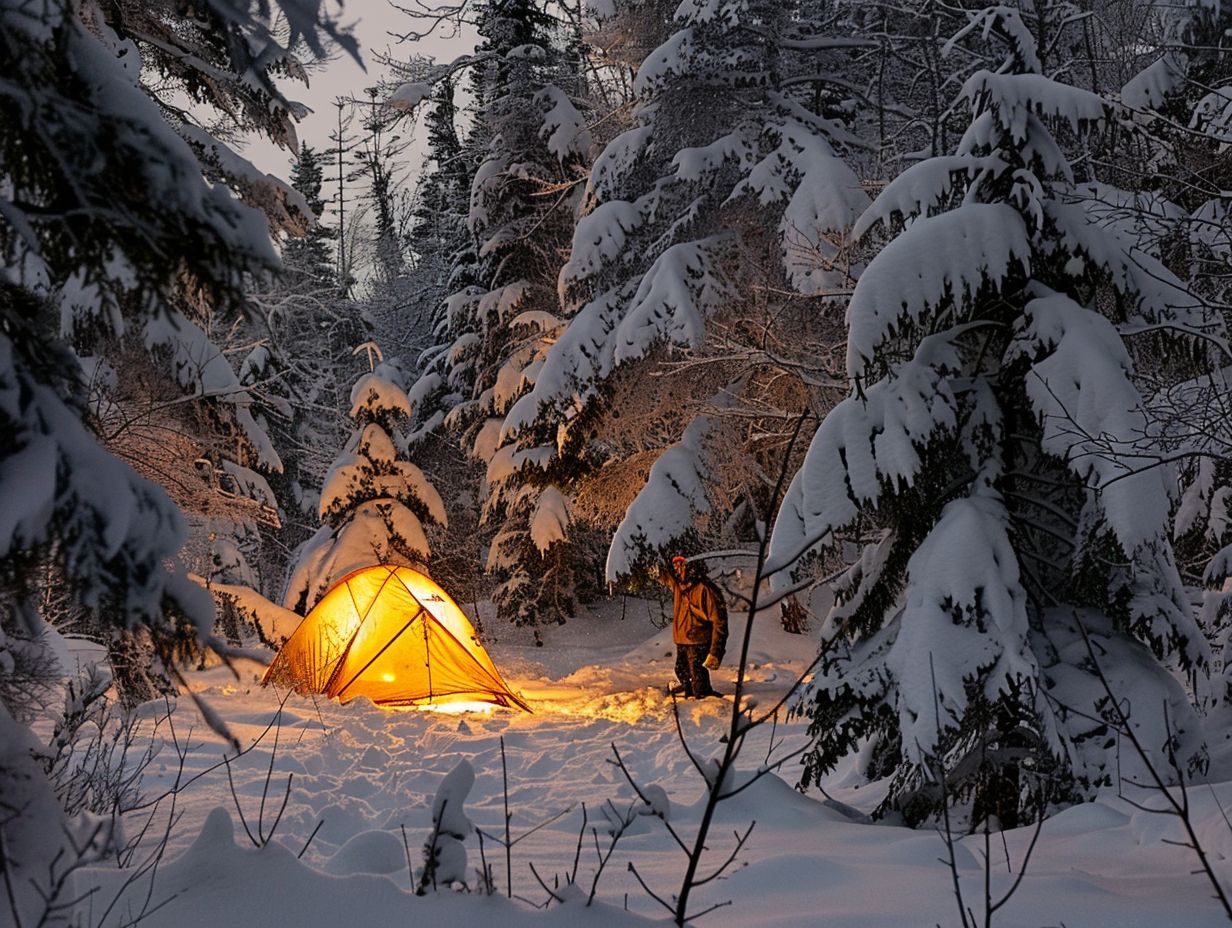
Participating in winter sports such as snowshoeing, cross-country skiing, and snowboarding can enhance the excitement and diversity of your snow camping experience.
Snowshoeing presents an excellent opportunity to traverse the snowy terrain and trails by foot, utilising specialised snowshoes designed to evenly distribute weight and prevent sinking. This low-impact activity not only offers a cardiovascular workout but also allows individuals to deeply engage with the surrounding nature.
Conversely, cross-country skiing involves gliding across snow-covered landscapes using skis and poles. This particular sport provides a comprehensive workout for the entire body, enhances balance and coordination, and can be tailored to different speeds in alignment with the participant’s skill level.
Snowboarding, a widely favoured winter sport, entails descending slopes while equipped with a snowboard affixed to the feet. Characterised by its thrilling and demanding nature, snowboarding appeals to those seeking an adrenaline rush within the context of stunning winter scenery.
How to Make the Most of Your Snow Camping Experience?
To optimise your snow camping expedition, it is advisable to structure a combination of outdoor activities and recreational pursuits that are in harmony with your preferences whilst capitalising on the distinctive winter setting.
Activities such as traversing picturesque trails on snowshoes, constructing a charming snowman, or participating in amiable snowball skirmishes can inject a sense of thrill into your journey.
It is essential to pack adequate warm and waterproof attire, a generous supply of snacks, and a dependable camping stove for preparing warm meals.
Allocating time for observing the starlit sky amidst the clear night and indulging in storytelling around the campfire can elevate the enchanting atmosphere of your snow camping escapade.
Embracing the tranquillity of the natural surroundings, disconnecting from technological devices, and forging enduring memories with your fellow travellers are integral components of this experience.
Frequently Asked Questions
1. How should I prepare for camping in snowy conditions?
Before heading out, make sure to check the weather forecast and gather all necessary gear and supplies. This includes a warm and waterproof tent, a cold-weather sleeping bag, multiple layers of warm clothing, and appropriate footwear for walking on snow.
2. Should I bring any specific types of food for camping in the snow?
Yes, it is important to bring high-energy and non-perishable foods for camping in snowy conditions. Foods such as nuts, dried fruits, energy bars, and instant meals are great options as they are lightweight and provide the necessary nutrients to keep you warm and fueled during your trip.
3. What are some safety precautions to take while camping in the snow?
Always pack a first aid kit and make sure to have a way to communicate in case of emergencies. It is also important to inform someone of your camping plans and check in with them regularly. Additionally, familiarise yourself with the signs and symptoms of hypothermia and frostbite and know how to prevent and treat them.
4. How can I stay warm while sleeping in snowy conditions?
Invest in a high-quality cold-weather sleeping bag and sleeping pad, and use a sleeping bag liner for added warmth. Make sure to change out of any damp clothing and dry them before getting into your sleeping bag. You can also use hand warmers or hot water bottles to warm up your sleeping bag before getting in.
5. What should I do if I get lost during my camping trip in the snow?
If you have a map and compass, try to retrace your steps or find a familiar landmark to orient yourself. If you have a GPS device, use it to locate your position and find your way back. If you are unable to find your way back, find a sheltered area and wait for help to arrive. It is also important to stay calm and conserve your energy.
6. Are there any specific tips for setting up a campsite in snowy conditions?
Choose a spot that is sheltered from strong winds and make sure to pack down the snow before setting up your tent. This will provide a more stable base and prevent your tent from collapsing under the weight of the snow. It is also a good idea to set up a tarp or groundsheet to create a barrier between your tent and the snow.

